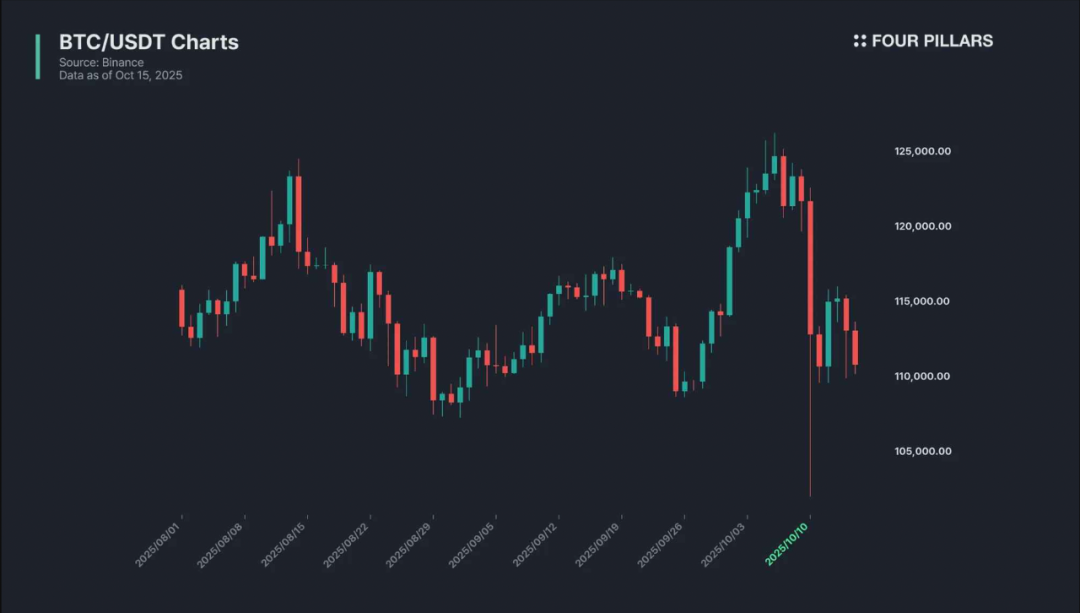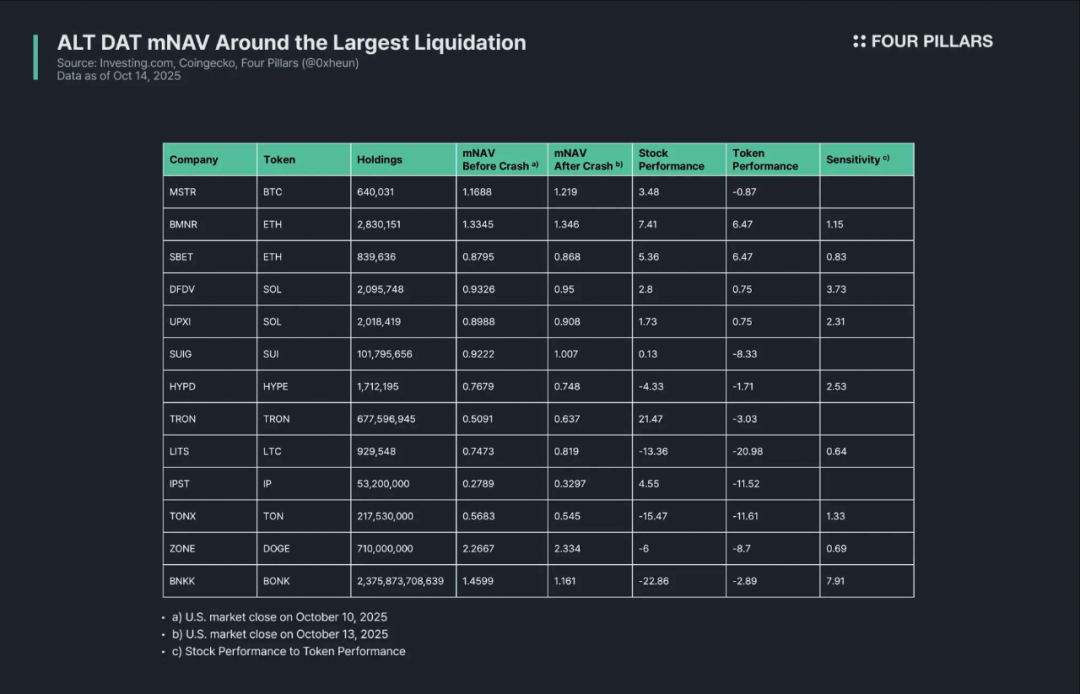We are currently in the ALT (Altcoin) DAT season (DAT, "Digital Asset Trust" or "Digital Asset Treasury," which refers to the strategy of publicly listed companies that prioritize the accumulation of digital assets as their core business function).
Since BitMine in July 2025, a large number of ALT DAT (Digital Asset Treasury (DAT) is a strategy of publicly listed companies that prioritize the accumulation of digital assets as their core business function.) companies have emerged in the market, but they have yet to undergo a true market downturn pressure test.
Against this backdrop, on October 10, 2025, the crypto market experienced a historic crash. The prevailing view is that the decline in stock prices of ALT DAT companies will be more severe than that of their corresponding tokens. But is this really the case? This article will analyze the resilience of ALT DAT before and after this crash by comparing mNAV (market net asset value multiple), stock performance, and token price fluctuations.
Written by: 100y/ Four Pillars
Translated by: ODIG Invest
Original report: https://4pillars.io/en/issues/is-alt-dat-szn-over
I. ALT DAT Season (The Digital Treasury Season of Altcoins)
DAT is one of the most important keywords in the crypto market of 2025. In July 2025, the emergence of BitMine and Tom Lee brought the concept of "ETH DAT companies" widely into the market. Seizing this opportunity, numerous companies and investors quickly collaborated to create DAT not only for blue-chip altcoins (such as SOL, HYPE, SUI, ENA) but also for meme coins (such as DOGE, BONK), and even for tokens that had not yet undergone TGE (such as 0G).
They adopted various financing mechanisms, such as ATM (additional issuance mechanism), PIPE (private investment in public equity), and SPAC (special purpose acquisition company). These companies not only purchased tokens from foundations under favorable conditions but also actively participated in staking and DeFi operations, even collaborating with ecological projects to diversify their business layout through aggressive strategies.
There has been widespread discussion in the market regarding the legitimacy of ALT DAT companies. However, from a macro perspective, whether enhancing accessibility or leveraging volatility to create opportunities, they are fundamentally no different from blue-chip DAT companies like BTC and ETH.
Although ALT DAT is indeed more susceptible to declines in the prices of underlying assets compared to blue-chip DAT strategies, their close collaboration with foundations, staking and DeFi activities, and greater convenience in token accumulation can all serve as potential advantages.
Despite the various risks associated with ALT DAT having been discussed long ago, they had never undergone a true stress test until the unprecedented crash in the crypto market on October 10, 2025.
II. The Crash on 10/10: Is the ALT DAT Season Over?
2.1 The 10/10 Crash

On October 10, 2025, U.S. President Trump announced an additional 100% tariff on Chinese goods, leading to an unprecedented crash in the cryptocurrency market. On that day, the total liquidation of long positions across major exchanges reached $19 billion, setting a record for the largest single-day liquidation in crypto market history.
Among representative assets, BTC fell by 16%, ETH by 21%; even relatively large-cap altcoins like SOL and BNB plummeted by 25% and 32%, respectively. ATOM, due to liquidity issues, crashed by 99% on Binance, briefly touching $0.001. October 10, 2025, became an extremely brutal day for Altcoins.
2.2 Is the ALT DAT Season Over?

When altcoins crashed, what happened to the stock prices of the DAT companies holding them?
In fact, many ALT DAT companies continued to operate their original businesses, but since shifting to the ALT DAT strategy, their core focus has changed to accumulating altcoins and using them for blockchain-related businesses. Therefore, the stock prices of ALT DAT companies are naturally highly sensitive to the prices of altcoins.
Thus, based on the closing data from October 10 and October 13, we compared the price changes of altcoins with the stock prices of DAT companies. Additionally, we analyzed the changes in mNAV and summarized the sensitivity of stock prices to altcoin price fluctuations in the table above.
An unfortunate situation is that the market crash on October 10 occurred after the U.S. stock market had closed. During the weekend, the crypto market rebounded significantly, while U.S. stocks were unable to trade. Therefore, the impact of this crash was not fully reflected in the stock prices of ALT DAT companies.
2.2.1 mNAV Analysis
mNAV Gainers:
MSTR (BTC), BMNR (ETH), DFDV (SOL), UPXI (SOL), SUIG (SUI), TRON (TRX), LITS (LTC), IPST (IP), ZONE (DOGE)
mNAV Decliners:
SBET (ETH), HYPD (HYPE), TONX (TON), BNKK (BONK)
mNAV is an indicator used to measure the ratio of a company's valuation to the value of its held altcoin assets. For DAT models that focus purely on asset management, mNAV = 1 is considered a normal level.
However, due to differences in existing business scale, management capabilities, financing methods, and types of underlying assets among companies, mNAV values naturally vary.
Interestingly, except for a few cases, most companies saw a slight increase in mNAV after the market crash. Even for companies with declining mNAV, the drop was quite limited, except for BNKK.
2.2.2 Sensitivity Analysis
Sensitivity > 1:
BMNR (ETH), DFDV (SOL), UPXI (SOL), HYPD (HYPE), TONX (TON), BNKK (BONK)
Sensitivity = 1:
SBET (ETH), LITS (LTC), ZONE (DOGE)
Negative Sensitivity:
MSTR (BTC), SUIG (SUI), TRON (TRX), IPST (IP)
Market participants typically view DAT companies as leveraged tools for their underlying tokens. In fact, a report by VanEck once described MSTR as a "convex bet" on BTC prices, suggesting that investors could gain exposure similar to call options. According to this logic, the "sensitivity" value measuring stock price changes relative to token price changes should be greater than 1.
However, analysis revealed that while most companies indeed had a sensitivity greater than 1, some companies fell below 1, and even some exhibited negative values.
2.2.3 Comprehensive Assessment
In the cases of ETH and SOL, the closing prices actually increased from October 10 to October 13. Most companies maintained or even improved their mNAV. MSTR (BTC DAT company) saw its stock price rise despite a slight decline in BTC prices, leading to an increase in mNAV. This indicates that blue-chip DAT companies like BTC, ETH, and SOL effectively maintained their mNAV amid significant market volatility.
In the analysis of other ALT DAT companies, the results were contrary to market expectations. Investors generally believed that once the prices of underlying altcoins fell, the mNAV of ALT DAT would also collapse. However, the opposite was often true. Companies like SUIG, TRON, LITS, IPST, and ZONE exhibited contrary trends, especially SUIG, TRON, and IPST, which saw their stock prices rise despite declines in their corresponding tokens.
This suggests that the valuation of ALT DAT companies is not as tightly correlated with the prices of underlying tokens as the market imagines. Possible reasons include that company valuations depend not only on token prices but also on leadership capabilities, financing structures, and the status of existing businesses.
Additionally, the relatively low market attention on ALT DAT stocks may also be a contributing factor. For example, on October 13, the trading volume of TRX on Binance was $317 million, while TRON's trading volume on Nasdaq was only about $4 million; IPST's trading volume that day was even just about $300,000.
As seen in the table, due to the significant differences in leadership, strategy, and business models among ALT DAT companies, it is difficult to draw a unified conclusion based solely on token prices. However, the following key observations can still be summarized:
For blue-chip tokens like BTC, ETH, and SOL, their market resilience is significantly stronger than that of other altcoins, and the core metric mNAV of the corresponding DAT companies remains robust as expected;
Other ALT DAT companies exhibited unexpectedly stable mNAV performance during this crash, which contradicts the general market assumption;
The sensitivity range is vast, spanning from 0.6 to 3-4, even reaching 7-8, indicating that tracking these relationships in conjunction with factors beyond the underlying assets will hold significant value in the future.
III. Is ALT DAT Really Over?
Since the crash on October 10, many believe that the DAT season has ended.
Indeed, although the prices of mainstream tokens have rebounded, many altcoins have yet to recover, making the situation for ALT DAT companies even more challenging. However, through the analysis of mNAV for ALT DAT companies, it is evident that, although further research is needed, they have demonstrated resilience beyond market expectations.
Of course, the difficulty of operating DAT companies and maintaining stock prices may gradually increase. Considering that accessibility and volatility are key factors in maintaining DAT premiums, as global regulations become clearer and the blockchain market shifts towards an institutionally dominated ecosystem, the attractiveness of DAT company stocks is expected to decline.
In fact, even BTC DAT company Metaplanet, which previously benefited from market premiums in Japan, recently recorded mNAV below 1 for the first time, reflecting the harsh market environment.
But one thing is certain: ALT DAT is not over.
In fact, many ALT DAT companies have outperformed their underlying altcoins in stock performance, which may actually provide them with an opportunity to build credibility and positive recognition among institutional investors.
Key observation points for the future of the ALT DAT field:
Subsequent Stress Tests: This crash is the first significant market test since the popularization of the DAT concept. Future observation is needed on the performance of ALT DAT companies' stock prices and mNAV during the next downturn cycle.
Trading Volume of ALT DAT Stocks: As regulatory clarity increases and institutional participation rises, the attractiveness of ALT DAT stocks may weaken. It is essential to closely track the long-term trends in their trading volume.
Sustainability of mNAV at 1: Currently, many ALT DAT companies have mNAVs below 1. Since mNAV > 1 is a key indicator for forming a positive feedback loop in the DAT model, it is worth observing whether these companies can return to above 1. If they cannot rebound, what consequences will arise?
Business Diversification: The competitiveness of ALT DAT companies lies not only in holding tokens but also in staking, DeFi operations, and close collaboration with ecological projects and foundations to deliver diversified products. It is worth paying attention to what strategies they will adopt to survive in fierce competition.
Competition Among Multiple ALT DAT Companies for the Same Altcoin: Unlike BTC, ETH, and SOL, most altcoins typically have only one ALT DAT company, as the DAT strategy relies on deep cooperation with foundations. However, in some cases, there are two or more ALT DAT companies corresponding to the same altcoin. In such instances, companies that collaborate more closely with the foundation may gain a competitive advantage, and the evolution of this competitive landscape is worth ongoing attention.
In the current crypto market, one must ask: In a highly volatile environment with undeveloped regulations and frequent narrative changes, where exactly are the boundaries of "asset financialization"?
Regardless, the resilience of ALT DAT still needs to be tested. It concerns not only the rise and fall of a sector but also serves as a collective examination of whether the crypto market can nurture a sustainable financial structure. Perhaps the real answer lies not at the peaks or troughs of price curves, but in who can still remain at the table after this round of retreat.
*This article is for learning and reference purposes only. I hope it is helpful to you and does not constitute any investment advice. DYOR.
免责声明:本文章仅代表作者个人观点,不代表本平台的立场和观点。本文章仅供信息分享,不构成对任何人的任何投资建议。用户与作者之间的任何争议,与本平台无关。如网页中刊载的文章或图片涉及侵权,请提供相关的权利证明和身份证明发送邮件到support@aicoin.com,本平台相关工作人员将会进行核查。




